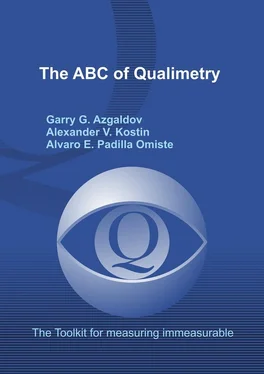The ABC of Qualimetry
The Toolkit for Measuring Immeasurable
Garry G. Azgaldov
Alexander V. Kostin
Alvaro E. Padilla Omiste
© Garry G. Azgaldov, 2016
© Alexander V. Kostin, 2016
© Alvaro E. Padilla Omiste, 2016
© Eric Azgaldov, translation, 2016
Created with intellectual publishing system Ridero

Professor Garry G. Azgaldov, a pioneer of Qualimetry, is a Doctor of Economics and a fellow of the International Academy of Informatisation, the Russian Academy of Natural Sciences, the Academy of Economic Sciences and Business, the Futures Research Academy, the Academy of Quality Problems and the International Guild of Quality Professionals. He is a chief researcher at the Central Economics and Mathematics Institute, Russian Academy of Sciences, Moscow.
Contact phone: +7(495)6143024; e-mail: gazgaldov@mail.ru

Alexander V. Kostinis a PhD in Economics, a certified appraiser of intellectual property, a corresponding member of the Academy of Quality Problems. He is a senior researcher at the Central Economics and Mathematics Institute, Russian Academy of Sciences, Moscow; the Creator of the on-line library QUALIMETRY.RU.
Contact phone: +7(916)1058104; е-mail kostin.alexander@gmail.com

Professor Alvaro E. Padilla Omisteis a Doctor of Education, a Biochemist and a Bolivian Chemist. He is a Lecturer of Distance learning programs, Education Management and Education Research Methodology at several Bolivian and Latin American universities; Author and Co-author of several books and articles on issues related mainly to the R & D and innovation.
Contact phones: +591 44721878 (home); +591 70713681 (mobile); e-mail: apadilla@icloud.com
Anything that people produce with in aperiod of time, as well as, anything they encounter in the course of commodity exchange and consumption and, generally in their everyday life, can be expressed by a set of four elements: products, services, information, and energy. 1 1 Some times information and energy are subsumed under products or services.
Each of these elementscan be fully described by three fundamental variables:
– Quantity (in conventional units of measurement);
– Cost of production, distribution 2 2 Distribution may be subsumed under consumption.
and consumption / utilisation / exploitation / application of a unit of quantity; and
– Quality of the unit of quantity.
The first of these, quantity, is basic to calculation in the engineering disciplines. The second, cost, is recognised and studied by the body of economic disciplines. As to the third characteristic, quality , until quite recently it was seldom if ever taken into account by either engineering or economic or management disciplines.
The reason was a lack of a theory and a toolbox for avalid quantification (assessment) of quality, such as the quality of products / services / information / energy. Without this kind of assessmentit is very difficult, if not impossible, to maintain an effective economic or social structure, e.g., an important omnibus structure called the quality of life, otherwise known as the standard of living.
The foregoing applies, among other things, to management, political, legislative or analytical activities.
For at least one time, almost every manager (as well as a policy-maker, law-maker or analyst 3 3 For simplicity here in after they will all be referred to as managers .
) has faced the problem of quantitative evaluation of quality, e.g., the need for quality control; depending on the specifics of their work it may be the quality control of an industrial or a social process (including the control of life quality), a design, a product, personnel, etc.
In every such situation what the manager has to do is to convert the quality of a controlled object —a production or social process, a design, a product, personnel, etc. – within a given time from a given state, A, to a target state, B. Clearly, the manager cannot solve this problem unless he/she is capable of quantifying A and B, that is, assessing the object’s quality in quantitative terms.
Hereinafter in this ABC we will often discuss quality with special reference to the quality of life as the most important, succinct and general description of socio-economic processes. The quality of other objects, e.g., products, will be used to make our examples more graphic.
Secondly, quality must be quantified in those frequent situations where a manager must decide between two or more options. For example, with superior quality in mind a manager has to decide:
– Whether a consumer product is to be imported or to be manufactured at home;
– On an organisation/administrative structure best suited for controlling a social or manufacturing process; or
– An equipment package for building infrastructure facilities in an urban setting.
When the number of options is greater than two, given that the quality of each option is determined by a combination of parameters (more about it later), the inescapable conclusion is that if one is to address this class of problem one must be able to quantify quality.
Lastly, we need to quantify quality when dealing with economic and social problems where, if we are to improve calculation accuracy, we have to take into account qualitative as well as quantitative factors (that is to say, if the former cannot be expressed in currency units), such as social, environmental, ergonomic or aesthetic ones.
With these considerations in mind the reader is introduced to an ABC of qualimetry, a relatively new scientific discipline concerned with the methodology and total quantitative assessment of the quality of different objects and of some of their qualitative characteristics that do not lend themselves to measurement in common monetary units. The fact is that despite there being a sizeable body of writing (more than 100 books with the term qualimetry in their title) any information found there is usually outdated and often plain wrong, which may lead to wrong decision making processes.
Because of the limited size of this text we can only describe the basics of qualimetry in its most common version rather than cover this discipline in full. For this reason Chapter 1 will focus on the so-called short-cut method of qualimetry. Unlike other methods, the approximate and the exact ones, it takes far less time to learn, understand and apply; however, it will help you solve, with reasonable accuracy, quite a few problems encountered in practice 4 4 For the same reason we will exclude from consideration other, less common types of qualimetric techniques.
.
This ABC will be useful to specialists in the executive, regulatory and legislative branches, as well as, to all those interested in the methodology of decision-making pertaining to the quality of different kinds of objects.
Читать дальше















